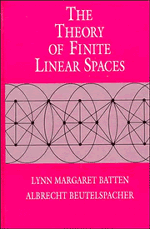Book contents
- Frontmatter
- Contents
- In memory of PAUL de WITTE 1931–1980
- Preface
- 1 The essentials
- 2 Complementation
- 3 Line sizes
- 4 Semiaffine linear spaces
- 5 Semiaffine linear spaces with large order
- 6 Linear spaces with few lines
- 7 d-Dimensional linear spaces
- 8 Group action on linear spaces
- Appendix
- Notation index
- Subject index
2 - Complementation
Published online by Cambridge University Press: 05 May 2010
- Frontmatter
- Contents
- In memory of PAUL de WITTE 1931–1980
- Preface
- 1 The essentials
- 2 Complementation
- 3 Line sizes
- 4 Semiaffine linear spaces
- 5 Semiaffine linear spaces with large order
- 6 Linear spaces with few lines
- 7 d-Dimensional linear spaces
- 8 Group action on linear spaces
- Appendix
- Notation index
- Subject index
Summary
Aim of the chapter
The aim of this chapter is to show explicitly how certain linear spaces can be embedded in a projective plane. Among such structures are the complements of two lines, of a triangle, of a hyperoval and of a Baer subplane. Here, the notion of a pseudo-complement is crucial. Suppose that we remove a set X of a projective plane P of order n. Then we obtain a linear space P-X having certain parameters (i.e., the number of points, the number of lines, the point- and line-degrees). We call any linear space which has the same parameters as P-X a pseudo-complement of X in P.
We have already encountered the notion of a pseudo-complement, namely the pseudo-complement of one line. This is a linear space with n2 points, n2 + n lines in which any point has degree n + 1 and any line has degree n. We know that this is an affine plane, which is a structure embeddable into a projective plane of order n. Another example may help to clarify the above definition. A pseudo-complement of two lines in a projective plane of order n is a linear space having n2 − n points, n2 + n − 1 lines in which any point has degree n + 1 and any line has degree n − 1 or n. (More precisely, the n − lines form a parallel class.)
- Type
- Chapter
- Information
- The Theory of Finite Linear SpacesCombinatorics of Points and Lines, pp. 22 - 32Publisher: Cambridge University PressPrint publication year: 1993



